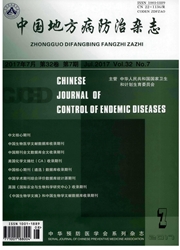

 中文摘要:
中文摘要:
目的了解高碘地区停供碘盐状况及对重点人群碘营养的影响,为制定高碘监测方案提供依据。方法每个县的高碘地区分布及食盐供应情况,将其分为单纯高碘、高碘和非高碘共存即“混杂地区”、全部停供碘盐、碘盐和无碘盐共存4种地区类型,分别进行分层抽样监测。每个层次均按东、西、南、北、中随机抽取9个乡镇,每个乡镇随机抽取4个村。每个村抽取8户居民半定量检测食盐样,同时抽取其中4户各采1名家庭妇女随意尿样检测尿碘。不足9个乡镇的层次,每个村抽取15户居民盐样。不足5个乡镇的全部监测。每类地区各选择1所乡镇小学和1所农村小学,整群抽取100名儿童检查甲状腺,检测随意尿样尿碘,由本人检测自带家中食盐。结果调查了3个县市的31个乡镇的121个村。高碘地区19个乡镇,非高碘地区12个乡镇。共检测居民户食盐1354份,碘盐率45.6%,无碘盐率54.4%。高碘地区碘盐率32.6%,无碘盐率67.4%;非高碘地区碘盐率70.1%,非碘盐率29.9%。检测妇女和儿童尿样1660份,尿碘(UI)水平(474.7±391.5)μg/L,尿碘中位数(MUI)354.7μg/L。妇女MUI为449.3μg/L,UI〈100μg/L的样本比例占5.6%、100~300μg/L的占30.0%、〉300μg/L的占64.4%;儿童MUI为321.44μg/L,UI〈100μg/L的样本比例占6.0%、100~300μg/L的占39.8%、〉300μg/L的占54.2%。妇女与儿童的MUI差异有统计学意义。高碘地区MUI为409.1μg/L,非高碘地区MUI为305.2μg/L,二者差异有统计学意义。3个县市甲状腺肿大率分别为2.2%、11.5%和3.0%。结论无碘盐率体现干预效果,尿碘反映碘营养水平,建议高碘地区以居民户食盐和妇女尿碘为主要监测指标,并实行分层抽样监测。
 英文摘要:
英文摘要:
Objective To master the effects of stopping iodized salt and iodine nutrition status of risk populations in excessive iodine intake areas to provide the monitoring project against it. Methods 4 kinds of areas were divided into many clusters, according to the conditions of whole iodine excess areas, iodine excess and non -excess areas, iodized salt stopped county of all townships, areas supplied iodized or non - iodized salt. 4 villages were selected 9 townships from one cluster. 8 households in each village were sampled for testing edible salt iodine by semi - quantitative analysis. Urinary iodine (UI) in woman from 4 households was tested at every village. 100 pupils were measured their goiter and UI for one cluster. Results 121 villages of 31 townships at 3 counties were investigated, including 19 iodine excess ones and 12 non iodine excess ones. 1 354 edible salt samples were tested. The rate of non - iodized salt was 54.4%, of iodized salt 45.6% in 3 counties. The rate of iodized salt in 19 iodine excess ones was 32.6%, of non - iodized salt 67.4% ; the rates of another 12 ones were 70. 1% and 29.9%. 1 660 samples of urine in women and children were measured. Mean of UI was 474.7±391.5 μg/L with MUI 354.7 μg/L. Women's MUI was 449.3 μg/L and children's MUI was 321.44 μg/L, with statistic significance. A total of 30.0% women's UI was adequate or more than adequate, in 5.6% insufficient and 30.0% excessive. 39.8% children's UI was adequate or more than adequate, in 6.0% insufficient and 54.2% excessive. MUI of iodine excess areas was 409.1 μg/L, another one was 305.2 μg/L. The proportions of 30.6% and 62.7% UI were between 100- 300 μg/L or over 300 in iodine excess areas; of 44.6% and 51.0% in non ones. MUI in two areas was statistic significance. Goiter rate of 3 counties was 2.2%, 11.5% and 3.0%, respectively. Eonelusions The rate of non - iodized salt could reflect the effects of stopped iodized salt. UI could represent iodine nutritional status of body. Edible salt at households and UI i
 同期刊论文项目
同期刊论文项目
 同项目期刊论文
同项目期刊论文
 期刊信息
期刊信息
